As the quality of AI translation surpasses my baseline expectations, I began to take my articles away from the Tower of Babel, unearthing a long-sealed desire. Last time, I compared the capabilities of three major translation engines: Google Translate, DeepL, and ChatGPT. This time, I will compare the top three multilingual WordPress plugins: Weglot, WPML, and Polylang, for WordPress users interested in translating their websites.
Talking on paper is not our style; please visit ckxpress.com to read this unboxing article and try switching languages on the site.
Weglot: Make Your Website Multilingual in Two Minutes
Don’t get me wrong; this is not Weglot’s slogan but my personal experience. Even if it were a slogan, it would only be a coincidence. This is not a sponsored post, and I have no coupons to offer.
A month ago, I attended the first WordCamp Asia in Bangkok, where I listened to a talk on “Take Your WordPress Site To Another Level Using AI Translation“. It reignited my desire to translate chungkin Express. Since I was sick in the hotel anyway, I figured there was no better time than the present, so I put the plan into action immediately. After narrowing down to the top three plugins, I tried Weglot first.
Experienced WordPress users know that, in general, installing a plugin takes about a minute, and Weglot is no exception. After installation, I made some simple settings and chose Traditional Chinese and English. Then, when I opened the blog, I was surprised. While I was still thinking about what to do in the third step, it turned out everything was already done. There was a language selection option at the bottom of the website, and the entire site had bilingual options, making it extremely user-friendly.
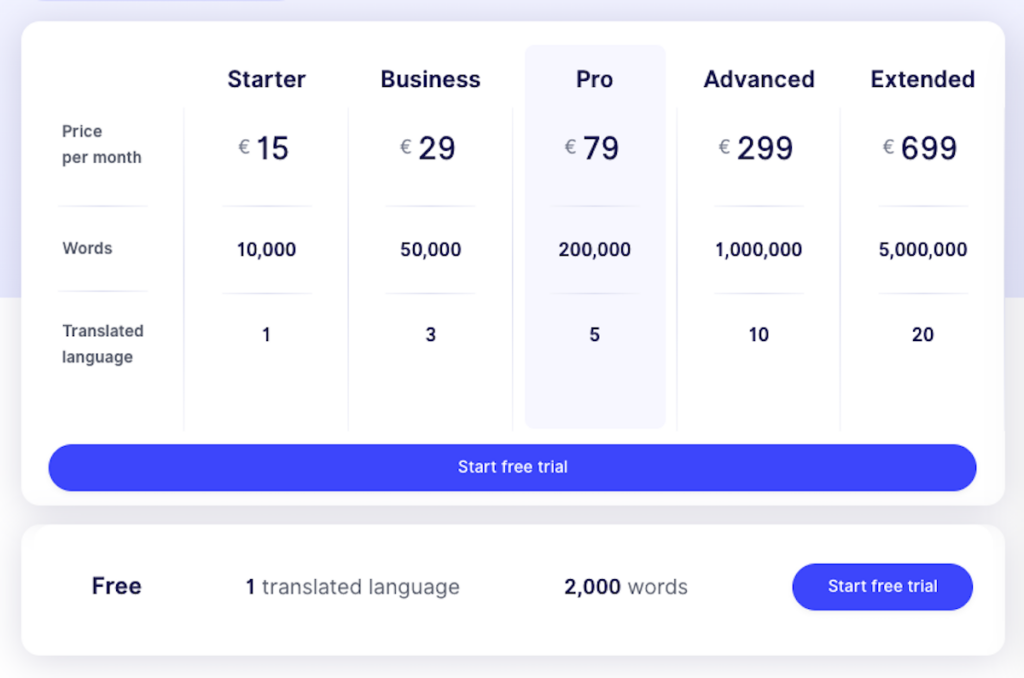
Equivalent exchange is a law, and convenience comes at a corresponding cost. First, there is the issue of control. In pursuit of ease of use, Weglot offers few options and is very lightweight. All translations are stored in Weglot’s cloud, with no changes made to the WordPress database. The advantage is that it does not mess with user data, but the downside is that the data is not in your hands. I have always advocated for self-determination, and whether it’s the limited options or content hosting, neither is my cup of tea.
Secondly, there’s translation quality. Weglot uses several mainstream AI translation engines, including DeepL, Google Translate, and Microsoft Translator, without letting users choose or even clarifying which one is used on their behalf. They only mention that it “employs a proprietary mix of leading machine translation technologies,” which I find quite annoying. Since it does not integrate with the GPT API, the results are generally acceptable but can be disastrous for challenging articles like the fishball theory.
However, the most critical issue is the cost. Weglot offers a free version but can only translate 2,000 words. After just reading one English version article, my quota was used up immediately. Saying that the entire website offers bilingual options is actually a magician’s trick; it appears that way on the surface, but translations are generated in real-time when you click on them. Since the speed is incredibly fast, it’s hardly noticeable. The problem is that if your translation quota is used up, the system will stop translating.
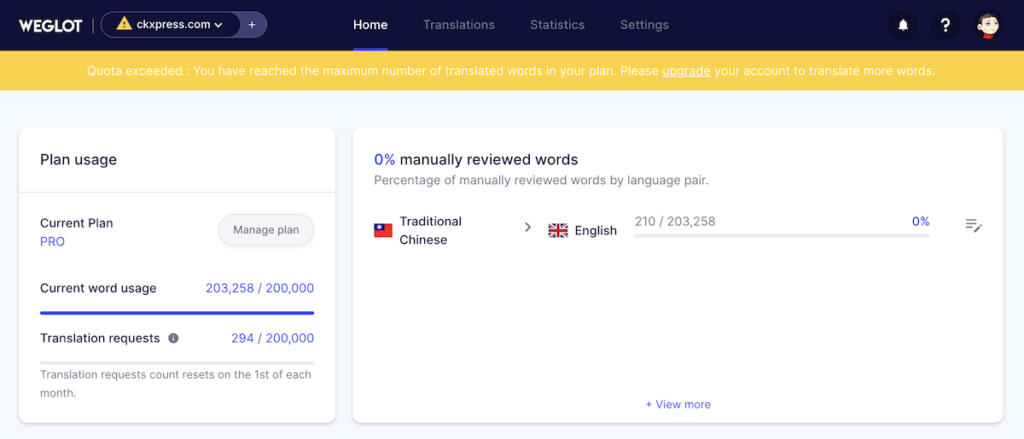
I was not satisfied yet, so I subscribed to the Pro plan for EUR 79 per month, allowing me to translate 200,000 words for further testing. However, in less than half a day, the 200,000-word quota was used up. To upgrade, I would have to pay EUR 299 per month, and that would only allow me to translate 1 million words. My website has around 2 million words, not to mention translating into languages other than English.
The most crucial issue comes later. Since all the translated content is hosted on Weglot’s servers, when you cancel the service, all translated content will disappear along with it.
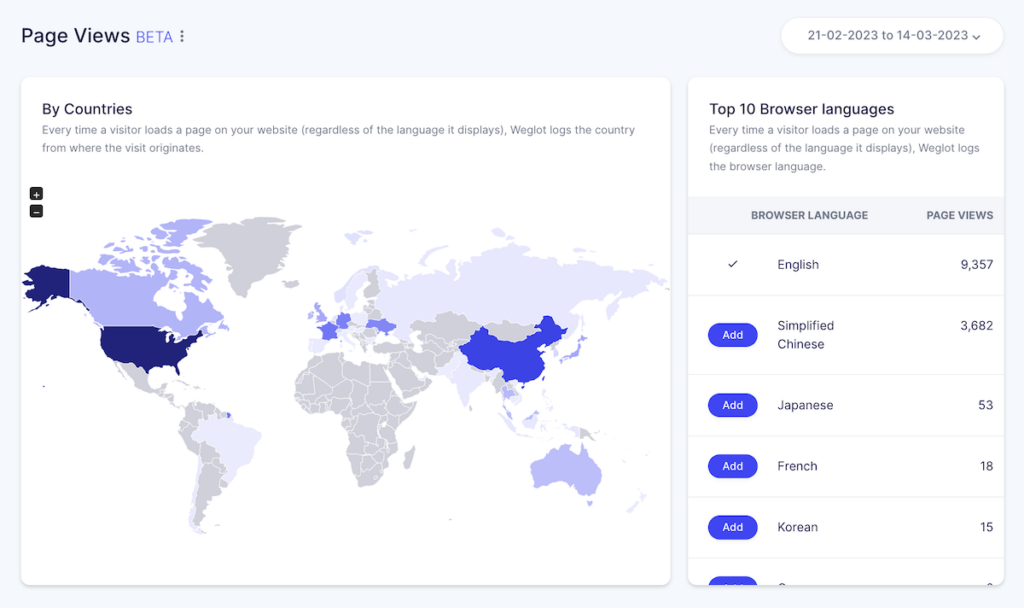
At this point in the “unboxing,” it is clear that this product is not suitable for me. I decisively canceled the subscription and decided to let it go after using it for a month. Before uninstalling the plugin, I checked the data, and there were over 9,000 pageviews from browsers with English as the default language in 3 weeks, mainly from the United States. Assuming these users do not understand Chinese (many Hong Kong people who speak Chinese are accustomed to using an English interface, including myself), I believe the number of readers would increase if the articles were available in English.

Simplicity: ⭐️⭐️⭐️⭐️⭐️
Price: ⭐️ (monthly subscription)
Translation quality: ⭐️⭐️⭐️⭐️
Suitable for: Websites with a large number of pages and widgets but not much text per page, such as e-commerce; users who prioritize ease of use and are willing to spend money to save time
Not suitable for: Bloggers who write long articles, makes little income and demands a lot
Inadvertently targeted writer

WPML: Powerful, but somewhat bloated
After uninstalling Weglot, the next plugin I tried was the most widely used WordPress translation plugin, WPML.
Unlike the other two plugins, WPML does not offer a free trial version but provides a 30-day “no questions asked refunds” policy, showing great confidence in their product. After testing it myself, I can confirm that I received a full refund without any issues, although it took a few days.
WPML is very powerful and can handle most use cases. Its design philosophy is the opposite of Weglot’s, being massive and even bloated. It also adds tables to the WordPress database, which makes me, a minimalist, hesitate.
The all-encompassing design philosophy of WPML can be felt from the moment the plugin is installed. Installing a zip package should be simple, but this company has created an installer, which they claim is for the convenience of installing WPML but is actually cross-promoting other products. It’s like you only need Microsoft Word, but you first have to install a core, and then, in addition to Word, they stuff you with Excel, PowerPoint, and a bunch of other things. While Microsoft has the scale and bargaining power, a small translation service is different. You may say that my minimalist tendencies are making a big deal out of a small issue, but I genuinely dislike it. If it weren’t for my desire to thoroughly compare several translation plugins, I would have given up on the installation and requested a refund right away.

To be fair, after completing the attention-seeking installation, WPML’s features satisfied me, even to the point of feeling overwhelming. This is most evident in the translation editor, which has good design intentions but runs slowly, especially since I’m used to using the Gutenberg editor. When handling translations, it becomes another editor, making it quite inconvenient to use. I can imagine that this is the result of years of accumulation. After all, WordPress has evolved from the classic editor to Gutenberg, and AI translation has gone from requiring extensive human intervention to only needing minor adjustments. As the environment has changed, the product’s long history has become a burden.
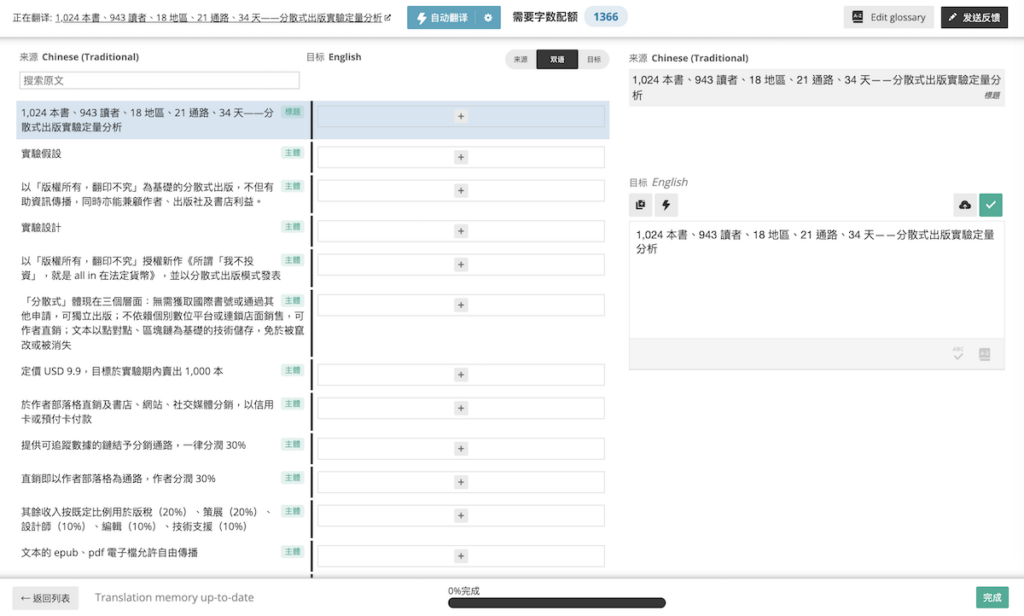
In terms of pricing, although WPML does not offer a free version, the selling price is reasonable, especially for users managing multiple websites. For just USD 199, it can support unlimited websites, with an annual payment for maintenance, which is quite cost-effective.
It’s worth noting that the one-time purchase price only includes a certain number of translation credits, which need to be purchased separately once they are used up. I assume this model is like selling razors cheaply because the real profit comes from the constantly replaced razor blades. I haven’t run a large amount of text through WPML for AI translation or purchased additional translation credits, so I cannot provide any reference regarding the cost of long-term reliance on WPML for translation and whether it is high or not.
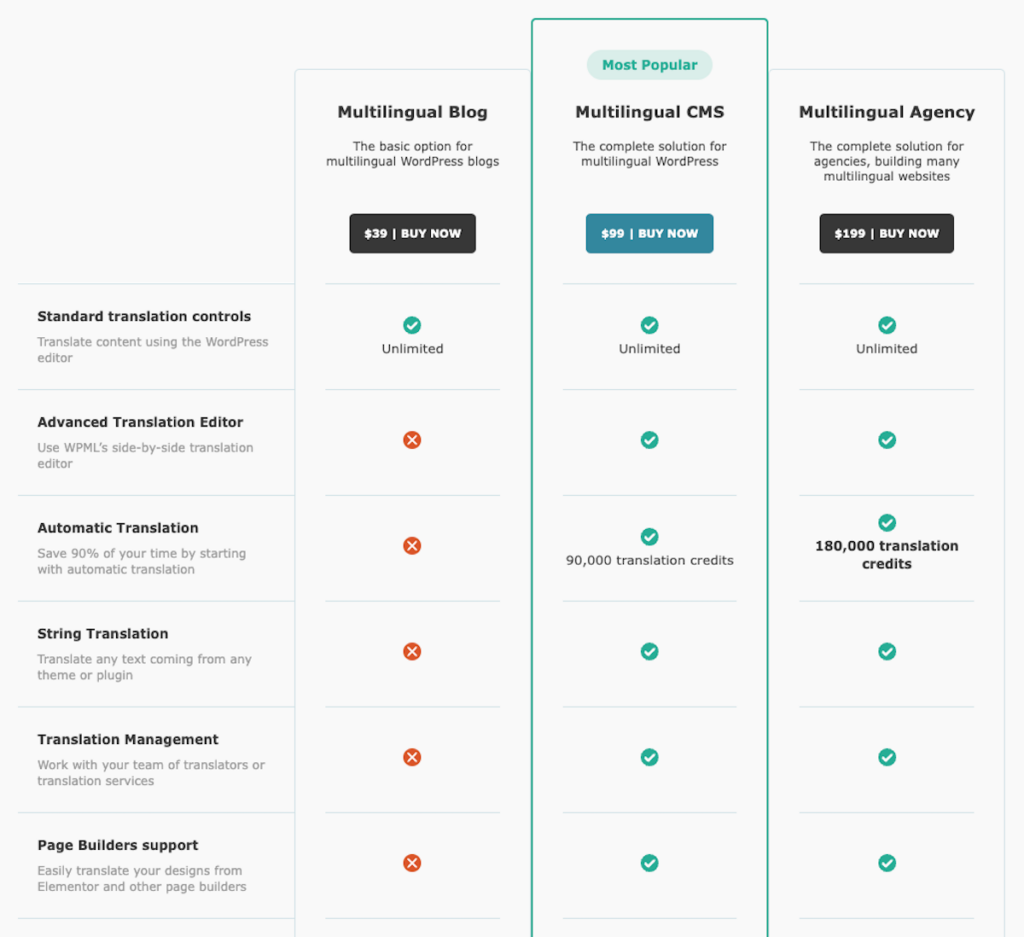
Like Weglot, WPML does not allow users to choose their translation engine and has not yet integrated ChatGPT. The issue lies precisely here, as it was the translation quality of the GPT model that inspired me to make my blog support multiple languages. WPML’s main selling point is the integration of AI translation, but it currently lacks the engine I need. If I continue to use WPML, I would have to manually paste the translated content, and since my articles are generally long and have few formats, the corresponding workload is not too large. However, WPML’s dedicated translation editor seems to have the opposite effect, making the task of manually pasting external translation results exponentially more time-consuming.
Overall, WPML has comprehensive features and a reasonable price. If it could add the GPT translation engine, it would be even more useful.

Simplicity: ⭐️⭐️⭐️
Price: ⭐️⭐️⭐️⭐️ (annual licensing fee)
Translation quality: ⭐️⭐️⭐️⭐️
Suitable for: Consultants managing a large number of websites; websites with more widgets and formats; websites requiring collaboration between professionals to proofread AI-translated content
Not suitable for: Exclusively ChatGPT users; minimalism enthusiasts
Lying still and getting shot again

Polylang: Less is more, simplicity is beauty
With WPML being “imperfect but acceptable,” I tested Polylang with a “looking for a better option while using the current one” mindset in another mirrored environment.
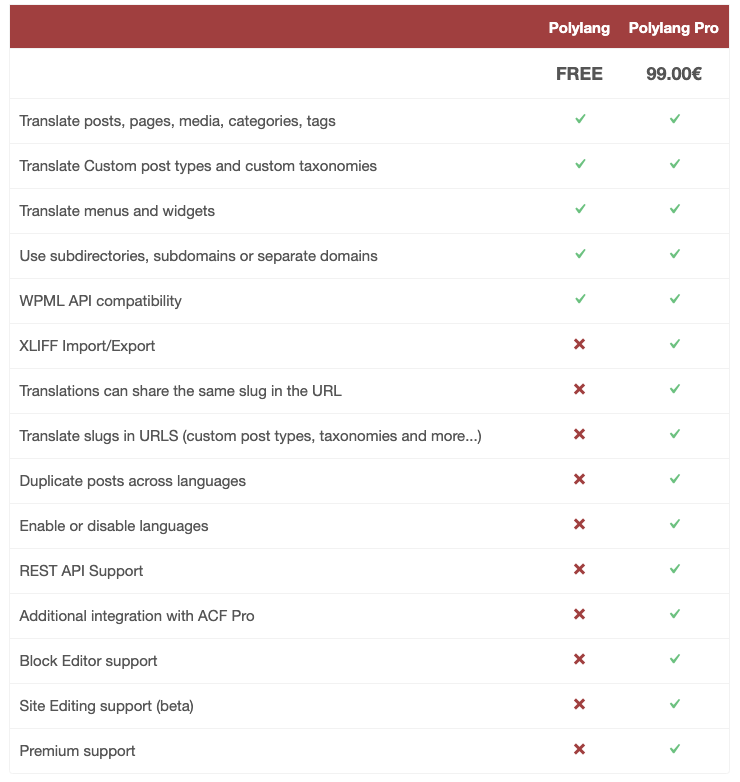
Polylang is available as a free version and a EUR 99 Polylang Pro. The former can barely meet the needs of small websites, but after trying it for a while, I determined that Polylang Pro is my “better option” and didn’t mind paying for the Pro version. What made me hesitate was deciding how many site licenses to purchase since I also help manage websites for some friends and organizations. Later, I found out that I only needed to buy a 1-site license first, as I could upgrade by paying the difference afterward. I have now increased my licenses to 25 sites.

It’s not that Polylang is astonishing, on the contrary, its features are quite ordinary. It simply allows websites to support multiple languages, with over 130 default languages including left-to-right languages, and even more niche languages can be defined by the user. You can even add the Amis language as long as you can write it. Once the website language is selected, Polylang Pro allows users to duplicate existing pages, including menu templates and other components, and then manually change them to the corresponding language. Strictly speaking, unlike the other two plugins, Polylang only provides multilingual support and does not offer translations. If you want to use translations, you need to install Ray Enterprise Translation separately.
However, Polylang’s “ordinary” features perfectly solve my core issue, providing enough flexibility for me to set up the scene according to my needs, without any unnecessary add-ons. Additionally, Polylang only uses WordPress’s original tables, which not only adheres to the minimalist principle but also demonstrates excellent engineering design.

Simplicity: ⭐️⭐️⭐️⭐️
Price: ⭐️⭐️⭐️⭐️ (annual licensing fee)
Translation quality: Not applicable (manage AI or professional translations independently)
Suitable for: Those who prefer translating outside of the WordPress backend, especially for more minimalist blogs with few formats
Not suitable for: Websites that require integrated AI translation or coordination among multiple translators through a plugin
Found the perfect solution

Summary
Comparing the three major plugins, WPML adds new tables to the database to store translated content, increasing the system load. Polylang maintains the database structure and uses existing tables to add records, without slowing down the system. Weglot is the most extreme, storing all translation content in its own cloud, without adding any burden to the user’s server, but as a result, users will lose all translation content once they unsubscribe.
For this “Tower of Babel” operation, I first chose ChatGPT as my AI translation engine before selecting a plugin. Both Weglot and WPML, which offer AI translations, have not yet integrated ChatGPT, rendering their original selling points useless for me. Polylang Pro’s minimalist design is just what I’m looking for, making the decision process straightforward. However, although I’ve chosen the right plugin for me, I wouldn’t call it the “champion” since the most suitable plugin depends on the website’s needs and requires individual analysis.
In fact, as a multifunctional content management system, WordPress should have included multilingual functionality in its core. We are glad to see it in the Gutenberg blueprint. However, it’s only planned for the fourth phase, otherwise, this article might not exist in the first place. Gutenberg started the development of the first phase of the new editor in 2018, and the second phase, full site editing, is about to be officially launched with WordPress 6.2 on March 28. After another three years, the third phase of multi-user collaboration development has begun, and it’s estimated that the fourth phase of multilingual support might be another three years away. It will be interesting to see what AI translation can achieve by then.
Extended Reading
- ChatGPT vs Professional Translation: Comparable quality, 1000 times more efficient, and 1/100,000 the cost
- WordPress: The backbone of the internet, a steadfast and enduring free software
- Postcard from Bangkok: WordCamp Asia 2023 Memories
My articles are not put behind a paywall and are all open for reading. If you like this article, please collect its Writing NFT to support writing and preserve journalism.


Leave a Reply